|
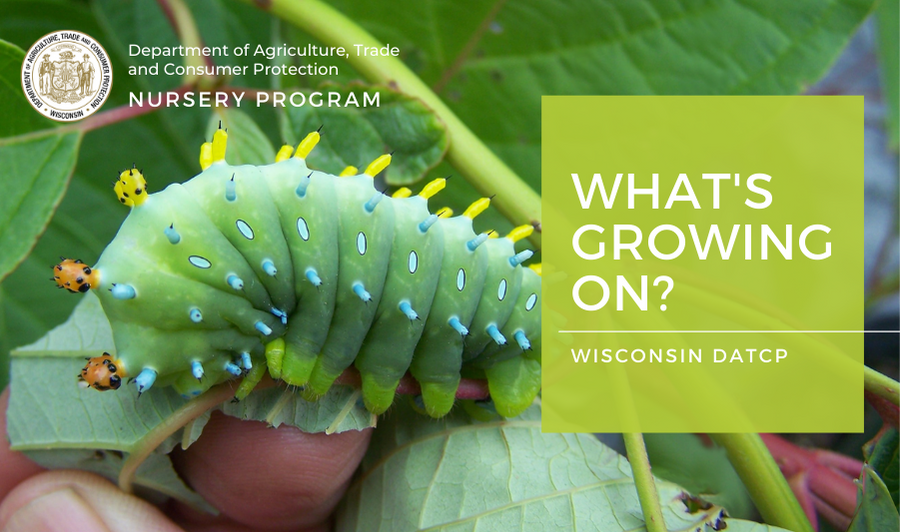 _____________________________________
Dear Wisconsin nurseries, Christmas tree growers, and gardeners:
Growing degree days (GDD)(simple B50) as of June 13 were 282 in Bayfield, 436 in Cumberland, 374 in Medford, 516 in Hancock, 569 in Green Bay, 679 in Racine, 693 in Madison, 673 in La Crosse and 835 in Dubuque, IA. A few pests in vulnerable-to-treatment stages include lilac borer, oystershell scale (brown), euonymus caterpillar at 275-500 GDDs and bronze birch borer, oystershell scale (gray), elm leaf beetle at 400-600 GDDs and euonymus scale at 500-700 GDDs. Other pests soon to be in vulnerable stages include woolly apple aphid (800-900), followed by cottony maple scale, European elm scale, fletcher scale, lecanium scale as well as two-spotted spider mite, European pine shoot moth and Japanese beetle all at 900-1200 GDDs.
Please send any feedback, questions, or ideas for future e-news updates to datcpnursery@wisconsin.gov.
Having trouble viewing this email? View it as a Web page.
_____________________________________
|
|
|
Box Tree Moth larvae, feeding damage and webbing on a boxwood | USDA H. Nadel
On May 22, 2024 the USDA Animal and Plant Health Inspection Service (APHIS) released a Federal Order providing new information on the expansion of quarantines for the Box Tree Moth (BTM) (Cydalima perspectalis, family Crambidae). The Order also highlighted that conditions have been established for interstate movement of regulated articles.
The federal BTM quarantine now includes the entire state of Massachusetts. Michigan has 12 counties completely quarantined and portions of two counties. New York now has 25 counties quarantined and the Ohio quarantine was expanded from four counties to include portions of two additional counties. BTM, whose larvae feed exclusively on boxwood (Buxus spp.), is spreading quickly since its initial detection in the U.S. in 2021. Long-distance spread of BTM is mainly the result of movement of infested boxwood.
From the Federal Order, “Boxwood plants may only be moved interstate from a quarantined area from an establishment operating under a compliance agreement, and only if accompanied by a certificate issued by a State Agricultural Authority certifying that the requirements of this Federal Order and the compliance agreement have been met. These requirements will prevent producers and distributors of boxwood from moving infested plants interstate. State Agricultural Authorities may prescribe additional safeguards and protocols.”
Some of the safeguarding requirements outlined in the BTM compliance agreement include:
- Trapping during the flight season (June through October).
- Routine scouting of boxwood production areas and any imported boxwood.
- Appropriately timed insecticide treatments targeting young caterpillars and also within seven days of any boxwood shipment.
- Pre-shipment inspection for each outbound shipment, after treatment, for any BTM lifestage or evidence of infestation.
- Pre-notification of shipments to the State Certifying Authority of the receiving state.
- Training of appropriate personnel on BTM identification, scouting techniques and BTM compliance agreement stipulations and regulation.
- Records for all of the above must be maintained for a minimum of 12 months.
Box tree moth has not yet been detected in Wisconsin. If you buy in boxwood from nurseries located in the BTM quarantine, be sure to inspect all incoming boxwood very carefully, and contact your nursery inspector immediately if you see anything you suspect may be box tree moth. You can monitor BTM development on the SAFARIS BTM pestcast webpage.

June 26, 2024, 12:00 p.m. Central Register here
Gain a comprehensive understanding of the Box Tree Moth Compliance Agreement, including goals, implementation strategies, and roles of various stakeholders. Attendees will also learn practical tips for complying with the agreement and mitigating the moth’s impact.
|
_____________________________________
|
|
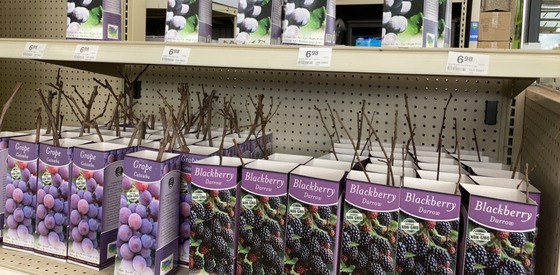 Nonviable Stock still on sales floor at a nursery dealer | DATCP G. Meysembourg

It's the time of year now when plants that have not yet leafed out or are not showing live buds are likely nonviable and cannot legally be sold. Trees and plants in late dormancy or which are suspected to revive late may be rehabilitated in a holding area outside of retail sales areas and may be returned to sale when healthy--otherwise, they should be destroyed or returned to the supplier if they are determined to be nonviable. Plant materials shipped with plastic-wrapped roots such as dry bulbs, vines, canes, trees and shrubs are especially prone to moisture deficiency problems during transport and should be sold within three weeks of arrival at retail stores.
Once bagged/packaged stock start showing signs of green growth they must then be treated like all other perennial stock, which means having ready access to sunlight and water. Preferably, they would be unpacked and potted up. If that is not possible, they need to be sold quickly, as there is a very small window of viability before the plant will die. Alternatively, they can be returned to the supplier.
Per Wisconsin statute 94.10(6)(a), "a nursery grower or nursery dealer shall maintain facilities that are reasonably adequate for the care and keeping of nursery stock held for sale, so that the nursery grower or nursery dealer can keep the nursery stock in healthy condition pending sale"; and 94.10(7)(b)2, nursery dealers cannot “sell, offer to sell, or distribute any nursery stock that the nursery grower or nursery dealer knows, or has reason to know, will not survive or grow.”
|
_____________________________________
|
|
 Elm Zigzag Sawfly feeding damage | Tom Macy, OH DNR Division of Forestry, Bugwood.org
The elm zigzag sawfly (Aproceros leucopoda), a non-native insect currently spreading westward towards Wisconsin, has the potential to cause death and decline to elms. Elm trees, once abundant throughout southern Wisconsin, have already seen significant decline due to the introduction of Dutch elm disease, caused by two invasive tree killing pathogens spread by elm bark beetles. Protecting remaining elms from additional non-native threats is crucial in slowing further tree loss.
Similar in appearance and behavior to a caterpillar, the sawfly larvae feed on elm leaves before pupating and becoming an adult. When trees have many larvae feeding on leaves, and heavy defoliation is seen year-to-year, the damage can cause decline to the trees. In the U.S. this pest often has multiple generations per year, resulting in feeding damage throughout the summer months.
The elm zigzag sawfly is capable of dispersing up to 56 miles a year on its own and is known to spread through the movement of nursery stock and soil. Not yet in Wisconsin, this pest can be found on the east coast and as far west as Ohio.
Keep an eye out for this pest by looking for its characteristic feeding patterns on leaves. Elm leaves with serpentine (zigzag) feeding patterns are the best way to detect the elm zigzag sawfly. If you suspect that you have seen this pest in Wisconsin, please report it to the DATCP Pest Hotline at: datcppesthotline@wi.gov or (866) 440-7523. Licensed nurseries should reach out to their local nursery inspector if they suspect they have this pest.
_____________________________________
|
|
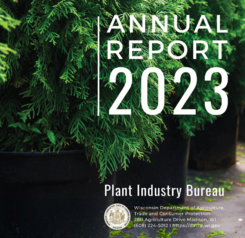
The DATCP Nursery Program is housed in the Bureau of Plant Industry. Our bureau strives to protect Wisconsin's agricultural and horticultural industries, and our natural resources by overseeing and ensuring compliance with laws and regulations involving plant pests, honey bees, nursery plants, Christmas trees, firewood, and seed. The bureau carries out control or eradication programs designed to prevent the spread of harmful pests like spongy moth. These programs include inspection, certification, quarantine, and survey activities.
The bureau's annual report outlines the regulatory and survey activities conducted over the past year to protect Wisconsin's agriculture, forests, and green industry from insects and diseases that pose an economic and environmental threat. Please check out our latest annual report when you get a chance. Discover highlights from 2023 and as well as trends from recent years.
|
_____________________________________
|
|
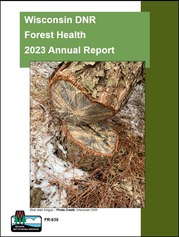 |
|
The 2023 WI-DNR Forest Health Annual Report was published in February 2024. From the DNR Annual Report webpage, "The DNR forest health team works to prevent, detect and control Wisconsin's forest pests, particularly invasive plants, insects and diseases that jeopardize trees and ecosystems. Through research, forest management guidance and education and outreach efforts, forest stability and sustainability is established and enriched."
|
_____________________________________
|
|
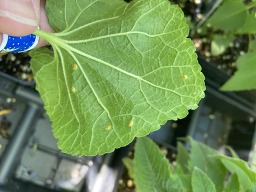 Hollyhock Rust on Hollyhock in Iron Co. | DATCP M. Sanders
|
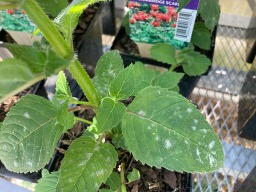 Powdery Mildew on Monarda in Sheboygan Co. | DATCP G. Meysembourg
|
|
 Spongy Moth caterpillars on apples and crabapple in Waukesha Co. | DATCP G. Meysembourg
|
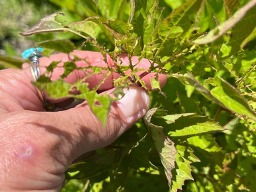 Viburnum Leaf Beetle larvae feeding damage on Highbush Cranberry Viburnum in Milwaukee Co. | DATCP M. Wensing
|
|
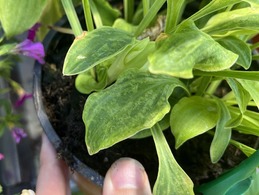 'Golden Tiara' hosta with symptoms of virus in Dane Co. | DATCP A. Kayfish
|
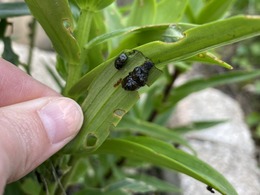 Lily leaf beetle larvae and feeding damage on Asiatic lily in Marquette Co. | DATCP L. Meils
|
|
|
_____________________________________
|
|
|
|
|